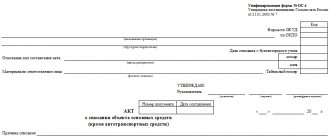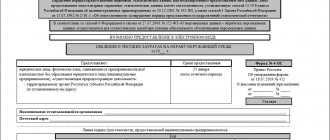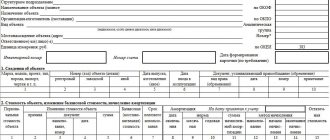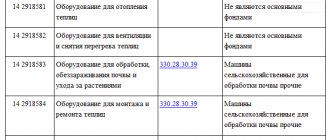Disposal of fixed assets
Before considering examples in which the disposal of property from operation can be considered a basis for write-off, it is necessary to determine when write-off is impossible.
The following changes in property movement are not a condition for write-off:
- if a capital structure or any other property is subject to modernization or reconstruction, while ceasing to participate in the activities of the enterprise, including its temporary conservation;
- if property is transferred from one unit to another within the same organization (an acceptance certificate is drawn up between the relevant responsible persons).
In these cases, the object continues to remain the main asset of the same organization, so there is no reason to remove it from the register and state the fact of disposal. The following reasons for the disposal of movable and immovable property from the assets of an enterprise, on the contrary, are the basis for writing off:
- unsuitability for further use;
- sale to a third party or individual;
- cases of gratuitous transfer to a third party or exchange for other types of property;
- replenishment of the authorized capital of another organization at the expense of this property;
- renting or leasing an object.
Let's consider each of the points in detail.
The meaning of the write-off procedure
Any NFA object of an organization may become unusable due to material or physical wear and tear, breakdowns and other factors. It makes no sense to continue to account for unusable fixed assets on the balance sheet. Objects that cannot be used in the future must be written off.
Key accounting tasks in relation to accounting for non-financial assets:
- Control over property assets from the moment they come into the possession of the enterprise, for example, from the moment of purchase until the moment they are completely disposed of (written off) from accounting. The task is accomplished by conducting a systematic inventory.
- Timely calculation of material depreciation in monetary terms. Reliable reflection of transactions in accounting.
- Receive reliable information about the property status of an economic entity for the preparation of reliable financial and tax reporting.
- Calculation and payment of fiscal payments to the state budget in terms of taxation of the organization’s property.
- Control over the effective use of funds aimed at reconstruction, modernization and repair of the company's operating system.
- Supervision of the effective operation of facilities in the production cycle or core activities.
The standard procedure for writing off fixed assets does not allow all non-financial assets of a budget-funded institution to be removed from accounting. For some types of objects you will have to obtain special permission from the owner or founder.
Unsuitability of property for further use
Disposal of property due to its unsuitability for use in the further activities of the organization can be caused by a number of reasons:
- physical or moral wear and tear;
- liquidation of an object due to an emergency (accident, natural disaster).
Guidelines for accounting of fixed assets prescribe the following procedure:
- An order is issued to create a commission
Documentation begins with the head of the organization issuing an order, which determines the members of the permanent commission for writing off fixed assets. The members of the commission are usually the chief accountant and other persons responsible for the safety of the organization's fixed assets.
- Members of the commission, determined by the order, inspect the facility to identify the further unsuitability of fixed assets for use by the organization.
Members of the commission are obliged to:
- establish the fact of the further unsuitability of the product, as well as the reasons for this;
- identify the persons responsible for the disposal of property from operation (if the corresponding reason is established - the fault of an employee of the organization or a third party);
- propose sanctions against those responsible (usually an order is issued at the end of the investigation);
- identify the possibility of further use of individual parts of unusable property;
- monitor the progress of removal of valuable and especially valuable materials from disposal property.
After this work is completed, documentation continues. A commission act is drawn up for the write-off of fixed assets in the established form OS-4 (in the case of write-off of vehicles - in form OS-4a), to which are attached various acts (acceptance, identification of culprits, condition of the object), drawn up during the inspection and necessary to substantiate the information in the form OS-4 (4a).
Next, the act is approved by the head of the enterprise and a corresponding order is issued confirming the disposal of the property. Based on this document, the responsible person makes a mark in the inventory card of the fixed asset and makes all the necessary entries.
The procedure for storing cards of decommissioned property is determined by the head of the organization by issuing an appropriate order.
An example of filling out an act for writing off groups of fixed assets
On March 29, 2020, the inventory commission found unused printers in the Office division of Mir Production LLC (replaced with new high-performance MFPs).
By order of the director dated April 1, 2020 No. 5, it was decided to sell the discovered printers.
Act on write-off of fixed assets (group of printers) dated 04/05/2020 No. 2 was drawn up on the basis of:
- inventory cards for printers;
- inventory act dated March 29, 2020;
- act of purchase and sale of printers dated 04/05/2020 No. 12.
The completed sample act is posted below:
Sale
If an organization decides that a property item must be disposed of from its production or non-production activities, it may be sold to a third party or individual.
[goo_mid]
The value of this property is determined at the conclusion of the sales contract and agreed upon by both parties.
Accounting for funds from the sale is complicated by the fact that there is usually some difference between the residual value of the property and its actual sale price, since market conditions often force the price of the property to be reduced in order to find a buyer.
We will consider the basic accounting entries and documentation when selling objects (transfer act, order, entries) in a separate article.
An example of filling out a vehicle write-off report
After inspecting the passenger car damaged in the accident, assigned to the Office division of World of Production LLC, the commission made a decision on the financial impracticality of restoration (defective act dated 02/25/2020 No. 2).
By order of the director dated February 26, 2020 No. 14, a decision was made to dismantle the car, sell scrap metal and place working parts in the warehouse.
The car was handed over to the contractor for disassembly. Parts that are in working condition are registered as spare parts. The scrap metal was transferred to a warehouse for sale.
Vehicle write-off report No. 3 dated 02/27/2020 was completed on the basis of:
- vehicle inventory card;
- defective act dated 02/25/2020 No. 2;
- certificates of deregistration with the traffic police;
- certificate of services rendered by the contractor dated February 27, 2020 No. 145;
- act for the receipt of materials from car disassembly dated 02/27/2020 No. 1 (form No. M-35).
A completed sample act is presented below:
Gift or exchange
When making a gratuitous transfer of fixed assets, a distinction is made between the donating organization and the recipient organization (person). If the cost of the object exceeds 5 minimum wages (Civil Code Art. 574) and the donor is a legal entity, then an agreement must be concluded, sealed by both parties, which stipulates all the terms of the transaction.
Documentation and accounting entries are complicated by the fact that usually the property has a residual value, estimated depreciation, and it is not put out of use until the contract is signed, during the donation procedure and until it is accepted by the other party.
Types of budget property
The owner of non-financial assets of public sector institutions is the state. According to paragraph 9 of Art. 9.2 of Law No. 7-FZ of January 12, 1996, fixed assets of budgetary institutions are assigned to them with the right of operational management. The following types of budget property are distinguished:
| OS type | Right of disposal |
| Real estate | |
| Any buildings, structures, premises, etc. | Operations on this type of OS without the official consent of the owner are unacceptable |
| Movable | |
| Particularly valuable property transferred or assigned by the founder to a budgetary institution, as well as purchased with subsidies | To carry out transactions using OCI data, the consent of the owner is required |
| Particularly valuable property acquired by a budgetary institution at the expense of its own income from business and other activities | The BU has the right to independently dispose of this OCI Exceptions in which the consent of the founder is required:
|
| Other movable | |
IMPORTANT! An exhaustive list of OCI, as well as the procedure for defining an OS as an OCI, is determined by the owner - founder of the budgetary institution. OCI are objects without which the implementation of the main activities of a state institution becomes impossible or difficult.
Contribution to the authorized capital of another organization
The disposal of property due to its transfer to the authorized capital of another organization has its own nuances. Depending on the form of ownership of the owner of the authorized capital, the value of the object and the method of accounting for it are assessed either on the basis of the Federal Law “On Joint-Stock Companies” or the Federal Law “On Limited Liability Companies”. The disposal is documented:
- act OS-1 - all objects, except permanent buildings;
- act OS-1a - structures and buildings;
- act OS-1b - for group transfer of property (sample documents approved by Resolution of the State Committee on Statistics of the Russian Federation dated January 21, 2003 No. 7).
In this way, the necessary documentation of the procedure for transferring the object is carried out. The accounting entries look like this:
- Debit - the original cost of the object and all cumulative expenses associated with the fact that disposal occurred.
- Credit - depreciation charges and financial proceeds from the transaction.
Expanded (sample):
- Dt inc 01 - Kt inc 01 - write-off of the original cost of the transferred fixed asset;
- Dt inc 02 - Kt inc 01 - write-off of the entire amount of accrued depreciation;
- Dt sch 91-2 - Kt sch 01 - reflection of the residual value of the fixed asset item - the subject of transfer;
- Dt sch 58 - Kt sch 91-1 - reflection of the monetary value of the contribution to the authorized capital, agreed upon by both parties;
- Dt sch 91-9 - Kt sch 99 - reflection of profit;
- Dt sch 99 - Kt sch 91-9 - reflection of loss.
Postings must be made exactly in the reporting period to which they relate.
Causes
An object is subject to write-off in the following cases:
- sale;
- cessation of use due to loss of value due to increased technological progress or performance as a result of work or inaction;
- liquidation in case of an accident, natural disaster and other emergency situation;
- transfer to the authorized capital of a third-party company or mutual fund;
- concluding an agreement of exchange or gift;
- making a contribution under a joint venture agreement;
- establishing the fact of shortage or damage to an asset during the inventory process;
- partial dismantling during reconstruction.
Find out how sick leave is paid on holidays. How to correctly fill out an advance report for a business trip? Find out here.
Rent, leasing
Regardless of whether the transfer of fixed assets is carried out under leasing or rental, Regulation PBU 6/01 provides for the following standards:
- property leased is accounted for both by the lessee organization (off-balance sheet contractual value) and by the lessor (at historical cost);
- if an entire enterprise is leased, then full records are kept by the rental organization;
- The lessor is responsible for calculating depreciation;
- the crediting of capital investments of the rental organization spent on the accepted property to one or another balance sheet is determined by the lease agreement;
- Leasing objects can be accounted for on the balance sheet of both the lessor and the acquirer.
Expanded accounting entries look like this:
- Dt sch 60 - Kt sch 51 - fixation of the contract price paid to the lessor;
- Dt sch 08-4 - Kt sch 60 - reflection of investments in non-current assets;
- Dt sch 19-1 - Kt sch 60 - reflection of VAT on fixed assets purchased for lease;
- Dt sch 68 s/account “Calculations for VAT” - Kt sch 19-1 - write-off of VAT;
- Dt sch 03, s/account “Property for leasing” - Kt sch 08-4 - accounting for funds for transfer to financial lease.
All movement of property is carried out only with the consent of the head of the organization holding the balance sheet, who issues the appropriate order and signs the act of write-off (the sample was approved by Resolution of the State Committee on Statistics of the Russian Federation dated January 21, 2003 No. 7).
Peculiarities
If the SPI of an asset has not yet expired, and operation for various reasons is no longer possible, it must be written off. Liquidation costs can be included in non-operating expenses.
According to the norms of the Tax Code of the Russian Federation, it is necessary to take into account some nuances:
- the residual value of fixed assets reduces income tax, but is taken into account in expenses differently, depending on the depreciation method;
- the decision to dismantle the facility is made by order of the director;
- if dismantling is not necessary in principle, for example, the asset burned down in a fire, the primary documents are used to document the removal of garbage, otherwise the Federal Tax Service will consider that the liquidation was not carried out.
VAT
In the letter of the Federal Tax Service of the Russian Federation dated April 16, 2018 N SD [email protected], based on the position of the Supreme Arbitration Court, it was concluded that the tax amounts previously accepted for deduction on acquired assets written off with depreciation of less than 100% do not need to be restored.
Organizations that do not have a license often have questions about the sale of scrap metal and accounting for the corresponding income generated from the write-off of fixed assets.
Such transactions are not subject to VAT.
This is stated in the letter of the Ministry of Finance of the Russian Federation dated 09/02/2015 N 03-07-07_50555, which classifies as an exception the situation with the sale of scrap metal obtained as a result of dismantling one’s own OS.
Income tax
There are two grounds for removing an asset from the balance sheet, which directly affect the calculation of the tax base:
- upon liquidation, dismantling costs and the difference between the initial price and accrued depreciation are included in costs that reduce taxable profit;
- upon sale, proceeds are reduced by costs associated with sales and residual value.
With simplified tax system
Organizations that apply the simplified system, when liquidating an operating system, take into account the market value of the received material reserves in non-operating income.
There is no need to incur any dismantling costs.
Disposal of a fixed asset is a complex operation, during which it is necessary to prepare primary documents, remove the object from the balance sheet and recalculate the tax base.
Dear readers! The article talks about typical ways to resolve legal issues, but each case is individual. If you want to find out how to solve your particular problem , contact a consultant:
+7 (499) 938-81-90 (Moscow)
+7 (812) 467-32-77 (Saint Petersburg)
8 (800) 301-79-36 (Regions)
APPLICATIONS AND CALLS ARE ACCEPTED 24/7 and 7 days a week.
It's fast and FREE !
Fixed assets









